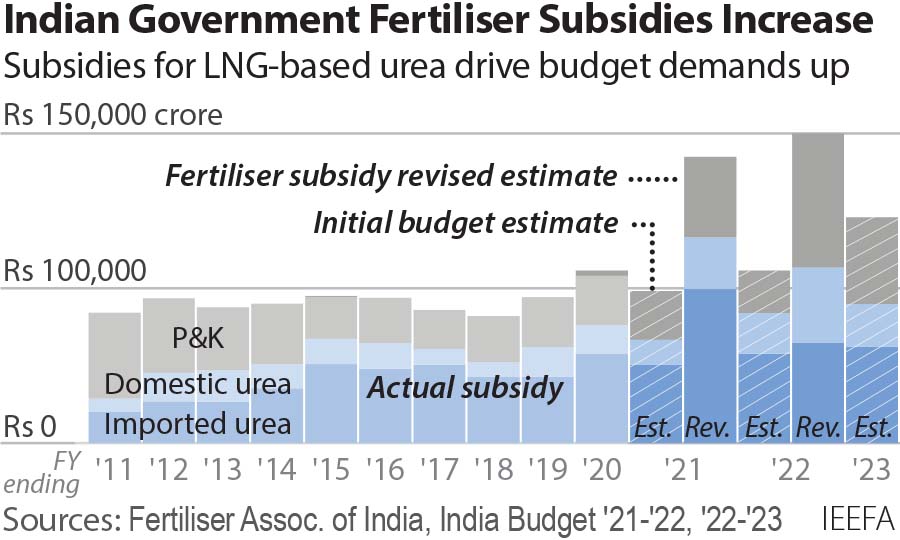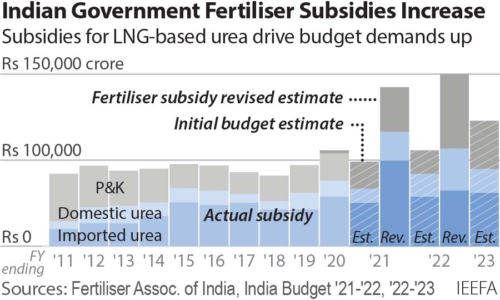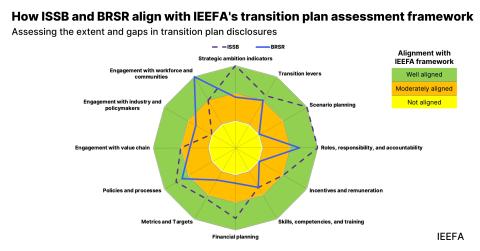IEEFA: Soaring LNG prices likely to drive up India’s Rs1 trillion (US$14 billion) fertiliser subsidy

14 March, 2022 (IEEFA): India’s heavy reliance on imported liquefied natural gas (LNG) as a fertiliser feedstock exposes the nation’s balance sheet to ongoing global gas price hikes, increasing the government’s fertiliser subsidy bill, according to a new report by the Institute for Energy Economics and Financial Analysis (IEEFA).
By shifting away from expensive LNG imports for fertiliser production and using domestic supplies instead, India could reduce its vulnerability to high and volatile global gas prices and ease the subsidy burden, the report says.
Key points:
- The Russia-Ukraine war has exacerbated already high global gas prices. This means the budgeted Rs1 trillion (US$14 billion) fertiliser subsidy is likely to increase.
- India can also expect a much higher subsidy due to a slowdown of fertiliser supplies from Russia, which will lead to soaring fertiliser prices globally.
- The use of imported LNG in fertiliser production is increasing. Dependence on LNG exposes India to high and volatile gas prices, and a higher fertiliser subsidy bill.
- In the longer term, the development of green ammonia will be critical to insulate India from expensive LNG imports and a high subsidy burden.
- As an interim measure, the government could allocate the limited domestic gas supplies to fertiliser manufacturing instead of to the city gas distribution network.
Natural gas is the main input (70%) for urea production, and even as global gas prices increased 200% from US$8.21/MMBtu (metric million British thermal unit) in January 2021 to US$24.71/MMBtu in January 2022, urea continued to be provided to the agriculture sector at a uniform statutory notified price, which led to an increased subsidy.
“The budget allocation for the fertiliser subsidy is about US$14 billion or Rs1.05 trillion,” says report author Purva Jain, IEEFA analyst and guest contributor, “making it the third year in a row that the fertiliser subsidy has topped Rs1 trillion.
“With the already high global gas prices exacerbated by the Russian invasion of Ukraine, the government will likely have to revise the fertiliser subsidy much higher as the year progresses, as it did in FY2021/22.”

This situation is compounded by India’s dependence on Russia for phosphatic and potassic (P&K) fertilisers such as NPK and MoP, says Jain.
“Russia is a major producer and exporter of fertiliser and supply disruptions due to the war are driving up fertiliser prices globally. This will further increase the subsidy outlay for India.”
To meet the higher input costs for domestically manufactured fertiliser and more expensive fertiliser imports, the government almost doubled its 2021/22 budget estimate for the subsidy to Rs1.4 trillion (US$19 billion).
The prices of domestic gas and imported LNG are pooled to supply gas to urea manufacturers at a uniform price.
LNG spot prices are forecast to remain above US$50/MMBtu through to September
With domestic supplies being diverted to the government’s city gas distribution (CGD) network, the use of expensive imported LNG in fertiliser production has been rising rapidly. In FY2020/21 the use of re-gasified LNG was as high as 63% of the total gas consumption in the fertiliser sector, according to the report.
“This results in a massive subsidy burden that will continue to rise as the use of imported LNG in fertiliser production increases,” says Jain.
“LNG prices have been extremely volatile since the onset of the pandemic, with spot prices reaching a high of US$56/MMBtu last year. LNG spot prices are forecast to remain above US$50/MMBtu through to September 2022 and US$40/MMBtu until the end of the year.
“This will be detrimental for India as the government will have to heavily subsidise the massive increase in urea production costs.”
As an interim measure, the report suggests allocating the limited domestic gas supplies to fertiliser manufacturing instead of to the CGD network. This would also help the government to meet the target of 60MT of urea from indigenous sources.
In the longer term, the development at scale of green hydrogen, which uses renewable energy to make green ammonia to produce urea and other fertilisers, will be critical for decarbonising farming and for insulating India from expensive LNG imports and a high subsidy burden.
“This is an opportunity to enable cleaner non-fossil fuel alternatives,” says Jain.
“The savings in subsidies as a result of reducing the use of imported LNG could be directed towards the development of green ammonia. And investment for the planned expansion of CGD infrastructure can be diverted to deploying renewable energy alternatives for cooking and mobility.”
Read the report: LNG in India’s Fertiliser Sector: A Trillion-Rupee Subsidy Burden
Media contact: Rosamond Hutt ([email protected]) +61 406 676 318
Author contact: Purva Jain ([email protected])
About IEEFA: The Institute for Energy Economics and Financial Analysis (IEEFA) examines issues related to energy markets, trends and policies. The Institute’s mission is to accelerate the transition to a diverse, sustainable and profitable energy economy. (www.ieefa.org)











